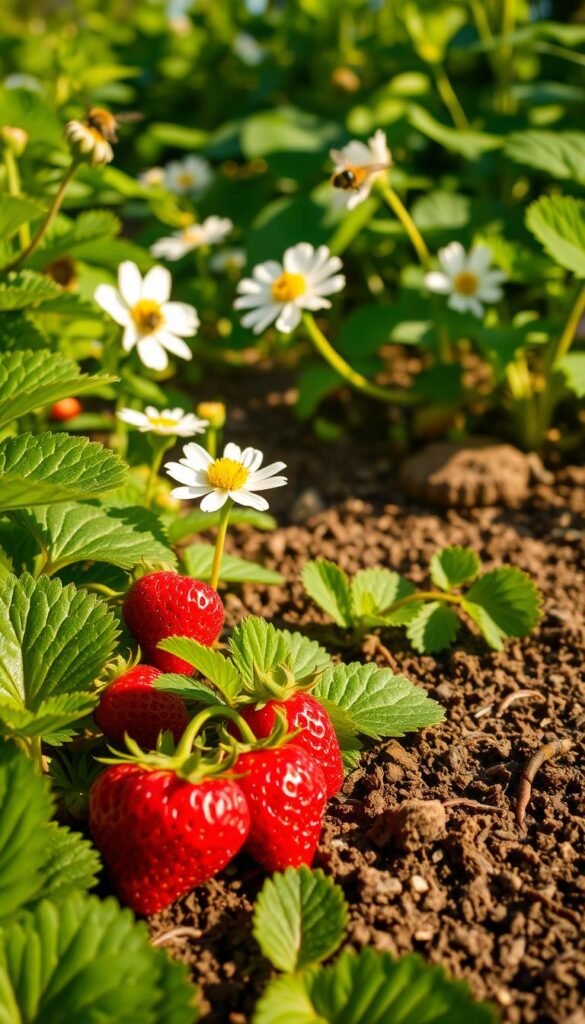Growing juicy, sweet fruit at home begins with understanding your plants. These perennial favorites thrive in raised beds, containers, or sunny patches, adapting well to various spaces. Modern varieties trace their roots to 18th-century hybrids, combining hardiness with exceptional flavor.
Healthy growing practices start beneath the surface. Rich earth teeming with microorganisms helps roots absorb nutrients efficiently, leading to stronger growth and better pest resistance. A U.S. Fish and Wildlife study shows native-friendly methods boost soil microbes by 29x compared to conventional approaches.
By nurturing your garden’s foundation, you create a welcoming habitat for bees, butterflies, and other helpful insects. This balance reduces reliance on chemicals while increasing yields. Did you know? Well-maintained plots can produce fruit for 3-5 years with proper attention.
Discover how supporting local wildlife strengthens your garden’s ecosystem. Vibrant blossoms attract pollinators that improve fruit set, while deep-rooted companions prevent erosion and improve water retention.
You’ll soon enjoy tastier harvests by working with nature’s rhythms. Simple changes like compost amendments or strategic planting make a big difference. Let’s explore how to cultivate resilience in every berry!
Laying the Foundation for Your Strawberry Garden
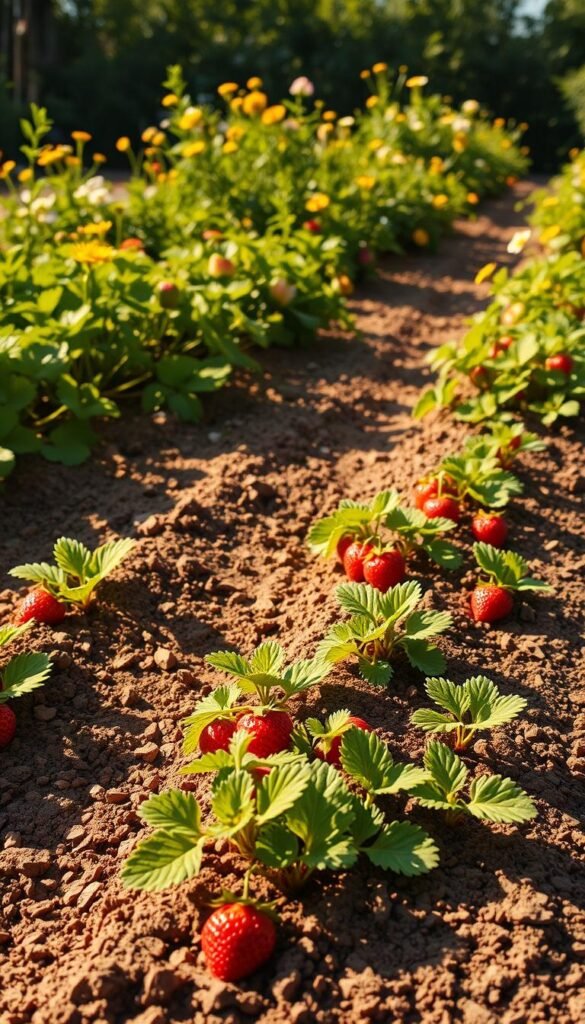
Your berry harvest’s potential hinges on two essential steps: picking the best cultivars and crafting nutrient-rich earth. Let’s break down how to set up a resilient growing environment that keeps plants thriving.
Choosing the Ideal Strawberry Varieties
June-bearing types deliver a burst of fruit in late spring, perfect for jam-making or freezing. Popular picks like Earliglow offer intense sweetness, while Jewel varieties provide firm, picnic-ready berries. Day-neutral cultivars like Seascape yield smaller batches from spring through fall – ideal for fresh snacks.
- Early-season: Annapolis (cold-hardy, medium fruit)
- Mid-season: Jewel (disease-resistant, large berries)
- Ever-bearing: Seascape (heat-tolerant, continuous yields)
Preparing and Amending Your Soil
Test your earth’s pH – aim for 5.5-6.8. Mix in 3 inches of compost or aged manure to boost drainage and nutrients. For slow-draining areas, build 12-inch raised beds to protect delicate roots from rot.
Remove all weeds before planting. Work organic material 8-10 inches deep – this creates fluffy, oxygen-rich conditions. Follow organic garden setup guidelines for optimal results. Mounded rows help water drain quickly after heavy rains.
Organic Strawberry Garden Care: Soil Health and Natural Pollinator Attraction
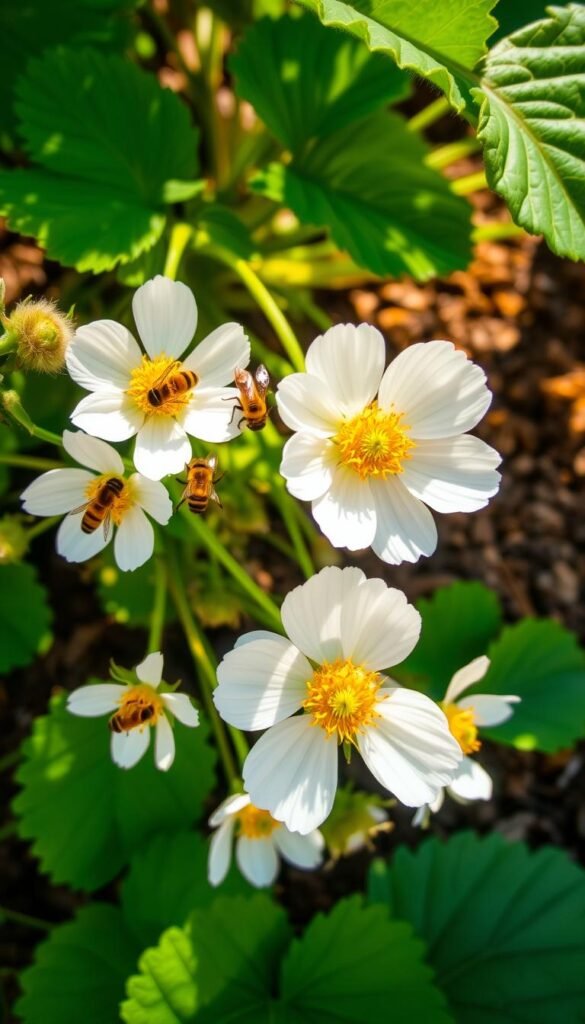
Your berry patch thrives when earthworms and microbes work overtime. Enrich planting areas with 2-3 inches of compost each season – this builds crumbly texture while feeding underground allies. Well-fed roots produce blossoms bees can’t resist, leading to plump, symmetrical fruits.
Buzzing visitors transfer pollen between white blooms, triggering the growth of those iconic red treasures. Each seed-studded surface hides a secret: what we eat is actually swollen stem tissue! For perfect form, ensure 6-8 bee visits per flower during peak bloom periods.
Boost mineral availability with rock dust or kelp meal. These slow-release amendments prevent nutrient burn while supporting vigorous growth. Test pH annually – slightly acidic conditions (5.8-6.2) help plants access iron and manganese for deep green leaves.
Stressed specimens attract pests, but natural pest management keeps problems in check. Mulch with straw to suppress weeds and maintain even moisture. Observe how ladybugs patrol lush foliage when soil biology flourishes!
Healthy systems yield surprising bonuses. Mycorrhizal fungi networks shuttle water to parched roots during droughts. Earthworm tunnels aerate compacted earth after heavy rains. This underground teamwork means fewer inputs and more flavorful harvests year after year.
Seasonal Strategies for Healthy Strawberry Plants
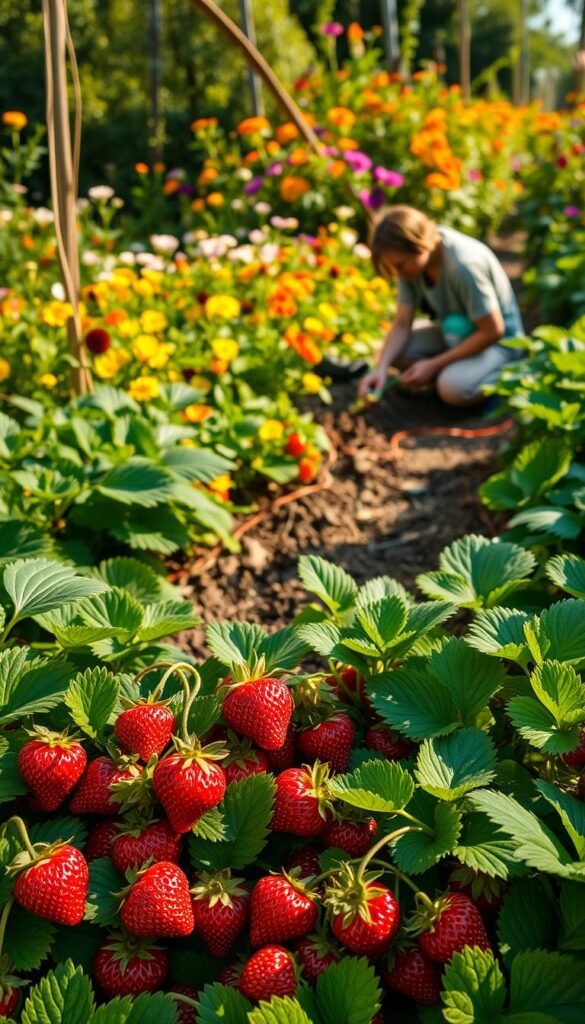
Timing is everything when nurturing fruitful crops through nature’s cycles. Your plants respond best when care routines match their growth phases and weather patterns. Let’s explore how to sync your efforts with the calendar for robust yields.
Spring Planting and Early Growth Tips
Start bare-root varieties in March or April as earth softens. Pinch off blossoms on June-bearing types their first year – this energy shift builds stronger roots for future harvests. Day-neutral varieties need monthly feeding from May onward.
Clear winter mulch after frost risks fade. Inspect crowns for damage and trim dead leaves. A fish emulsion boost in early spring fuels leafy growth and flower clusters. Consistent moisture during bloom periods ensures plump berries.
Fall Maintenance for Winter Protection
Prep plants for cold by cutting water in late September. Apply potassium-rich amendments to strengthen roots before dormancy. Remove spotted leaves to prevent disease carryover.
After the first hard freeze, tuck plants under 4 inches of straw mulch. This blanket regulates soil temps and prevents frost heave. Follow this seasonal care guide for year-round success. Your efforts now guarantee vigorous regrowth when warmth returns.
Effective Organic Fertilizing and Mulching Techniques
Nourishing your fruit-bearing plants requires more than occasional attention—it demands smart feeding strategies. The right mix of amendments keeps roots strong while encouraging sweet, juicy yields. Let’s explore how to pair earth-friendly fertilizers with protective ground covers.
Balancing Nutrients with Organic Fertilizers
Slow-release meals feed plants gradually, matching their growth cycles. Blood meal (13% nitrogen) sparks leafy growth in spring, while feather meal’s 15% nitrogen sustains roots through fall. Combine these with bone meal for phosphorus and kelp for potassium.
Apply nitrogen-rich options when plants awaken in March and after summer harvests. This timing supports both foliage and future blossoms. Avoid overdoing it—excess nitrogen creates lush leaves but fewer fruits. Aged manure works well, but skip fresh poultry waste to prevent root burn.
- Fish meal: Balanced NPK + trace minerals
- Soy meal: 7% nitrogen with quick release
- Alfalfa pellets: 3% nitrogen + growth stimulants
Mulch does double duty by conserving moisture and suppressing weeds. Spread 2-3 inches of straw or shredded leaves around plants, keeping it 2 inches from crowns. As it breaks down, mulch feeds earthworms and improves soil structure naturally.
Pair these methods with permaculture gardening principles for a self-sustaining system. You’ll notice plumper berries and fewer pest issues as your garden finds its rhythm!
Managing Pests, Runners, and Diseases Organically
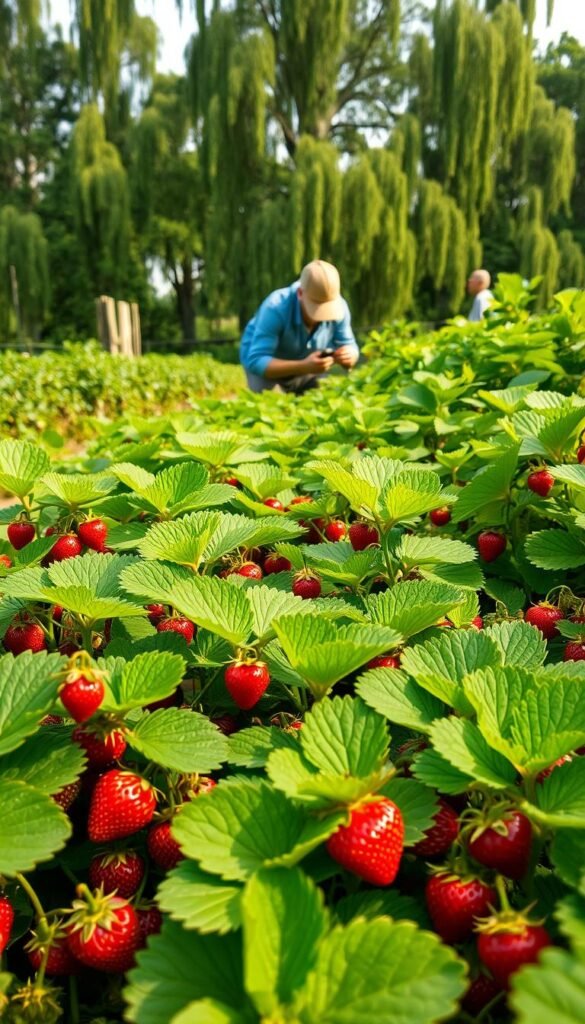
A healthy berry patch isn’t just about growth—it’s about defense. Smart strategies help your plants thrive while keeping common threats at bay. Let’s explore how to maintain balance without harsh chemicals.
Natural Methods to Control Pests and Diseases
Prevention starts with smart spacing. Leave 18-24 inches between plants to improve airflow and reduce fungal risks. Remove fallen leaves promptly—they harbor spores that cause leaf spot and gray mold. For crawling insects like slugs, sprinkle food-grade diatomaceous earth around plant bases.
Companion planting works wonders. Marigolds repel nematodes, while borage attracts predatory wasps that target sap beetles. If you spot curled leaves or stunted growth, explore organic pest control methods for early intervention.
| Threat | Signs | Solution |
|---|---|---|
| Spider Mites | Webbed undersides of leaves | Spray neem oil weekly |
| Botrytis Rot | Gray fuzzy fruit | Remove infected berries immediately |
| Leafhoppers | Yellow stippling on leaves | Introduce ladybugs |
Controlling Runners and Weeds for Better Yields
Runners sap energy from fruit production. Pinch off 80% of them during peak growing season to boost berry size. Keep 2-3 strong runners per plant if expanding your patch—root them in small pots for easy relocation.
Weeds compete fiercely for nutrients. Lay fresh straw mulch every 6 weeks to block sunlight from weed seeds. For persistent invaders, hand-pull when soil is moist to remove roots completely. A sharp hoe works between rows without disturbing shallow roots.
Enhancing Biodiversity to Attract Beneficial Pollinators
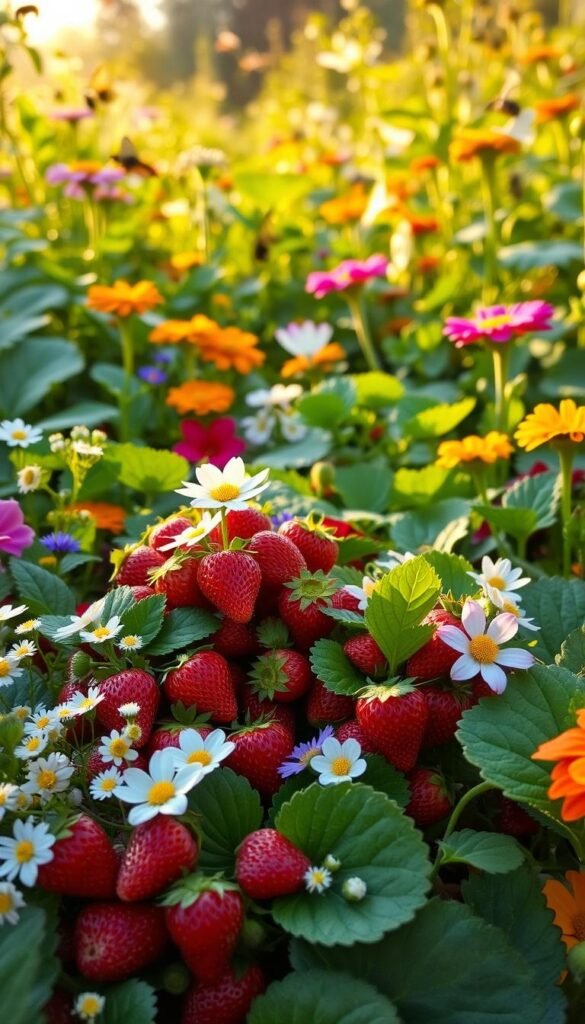
Transform your berry patch into a buzzing sanctuary that works smarter, not harder. Strategic plant choices create a thriving ecosystem where helpful insects handle pollination and pest control naturally.
Flower Power for Fruit Success
Early bloomers set the stage for success. Crocuses and dandelions offer vital nectar when strawberry blossoms first open. These pioneers keep bees visiting your beds daily, leading to better fruit formation.
| Companion Plant | Bloom Period | Key Benefit |
|---|---|---|
| Borage | Spring-Fall | Attracts 58% more bees |
| Clover | Summer | Fixes nitrogen in soil |
| Calendula | All Season | Repels harmful beetles |
Mid-season stars like marigolds pull double duty. Their bright petals lure hoverflies that devour aphids, while roots suppress nematodes. Let herbs like oregano flower – their tiny blooms feed parasitic wasps that target fruit pests.
Leave some areas wild for ground-nesting bees. Stack hollow stems or install bee hotels to shelter mason bees. These efficient pollinators visit 2,000 flowers daily – six times more than honeybees!
Well-pollinated blossoms develop into plump, symmetrical fruits. Studies show diverse plots yield 40% more berries with richer flavor. Your tasty harvest becomes nature’s thank-you note for creating this vibrant habitat.
Final Insights for a Bountiful Strawberry Harvest
Cultivating a thriving patch requires attention to detail and patience. Consistent care yields sweeter rewards – aim to check plants weekly during peak production months. Remove damaged leaves promptly to redirect energy toward developing fruits.
Protect your investment through winter by mulching beds with 3 inches of straw after temperatures drop. This shields roots from freeze-thaw cycles while suppressing early weeds. Come spring, gently rake back the cover as new growth emerges.
Water deeply but infrequently to encourage strong root systems. Morning irrigation reduces evaporation and prevents fungal issues. Pair this with annual soil tests to maintain ideal growing conditions.
Rotate planting locations every 3-4 years to prevent disease buildup. Propagate healthy runners in fresh ground each season to renew your stock. With these strategies, you’ll enjoy plump berries that burst with flavor – nature’s perfect snack straight from your backyard!

